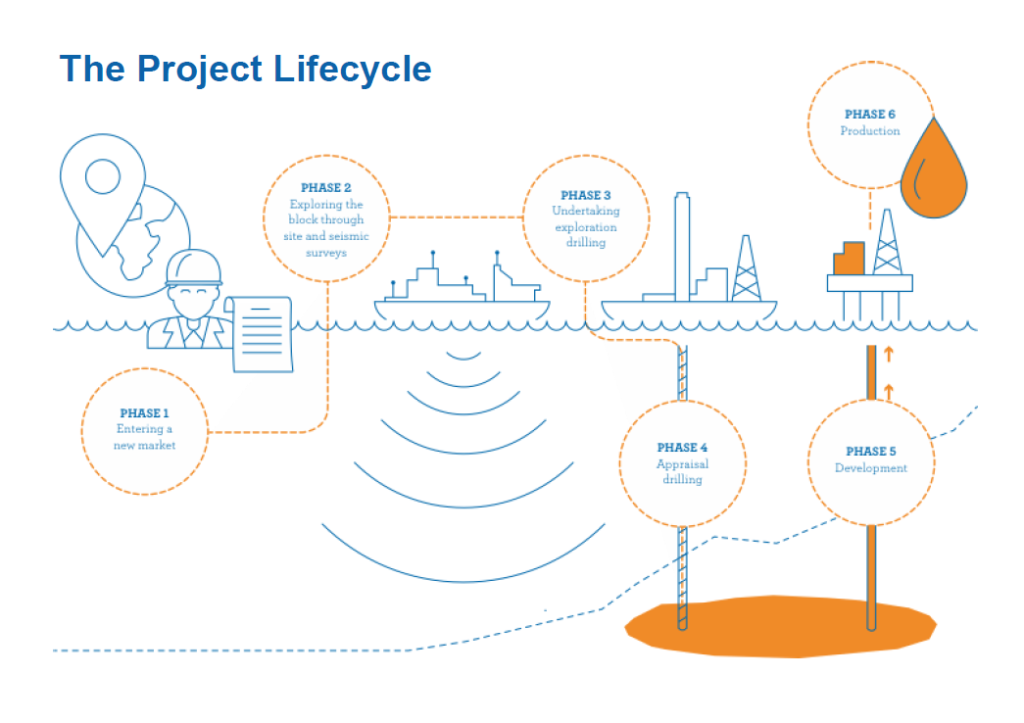
Phase 1 – Entering a New Market
The first step in the project lifecycle is a regional petroleum system analysis, during which explorers identify under-explored basins or overlooked geological territories with hydrocarbon potential. The oil and gas company (“operator”) also acquires any existing seismic surveys. Using all of this information, the operator assesses the geopolitical, operational, and financial viability of operating in the territory. The right to explore these areas is then secured through licenses with host governments. This process can take up to a year.
Phase 2 – Exploring The Block Through Site and Seismic Surveys
The next step in the process of hydrocarbon exploration is conducting 2D or 3D seismic surveys. These surveys use sound waves to map rock formations on and below the ocean floor to establish the potential presence of oil or gas. If the seismic surveys show that formations potentially containing oil and gas may exist (“prospects”), then the operator will determine where to drill an exploration well. Operators may consider bringing in – or farming-in – other oil and gas companies at this stage. Typically, this stage of the project takes one to two years.
Phase 3 - Undertaking Exploration Drilling
Before beginning exploration drilling, a company conducts Environmental and Social Impact Assessments to understand and evaluate the social and environmental implications of drilling operations. Prior to the actual drilling of an exploration well, an operator develops an oil response plan that is then approved by the Government.
During the exploration drilling phase, at least one well is drilled into the seabed to test a prospect. Additional information on seabed and subsea conditions is also gathered. One of three scenarios can result from exploration drilling. The first scenario, a dry hole, means that no oil or gas has been found and the well will then be plugged, sealed, and secured. The second scenario, a non-commercial well, occurs when oil and gas is found, but the well is not commercial. If a non-commercial well is discovered, further exploratory drilling may be undertaken. The third scenario, a discovery, occurs when a well is found to be “hydrocarbon-bearing.” A hydrocarbon bearing well is then further tested to determine viability. This phase of the process takes from one to three years.
Optional Action – Exiting the Block
In some circumstances, companies that don’t find oil and gas may look to relinquish their license(s) or opt not to renew their license(s). This can happen at any point during phases two and three. A licensee can give up acreage by either surrendering part of the licensed area while the license continues over the remaining area, relinquishing the entire license, or deciding not to renew the exploration license when the contract expires. Depending on the original license agreement, the company may have certain obligations to complete, such as social investments, before it is released from the agreement.
Phase 4 - Appraisal Drilling
If exploration drilling suggests that promising amounts of oil and/or gas exist, an operator will proceed with appraisal drilling. This process may involve drilling multiple wells to assess the size of the oil or gas discovery and whether it is commercially viable system. If a discovery is deemed commercially viable, the operator can move on to development. Social and environmental impact of appraisal drilling is comparable to exploration drilling. This phase of the process takes from one to three years.
Phase 5 - Development
The development phase begins when a development plan is submitted to relevant national authorities for approval. Then, assessments must be carried out on all areas of potential risk, including the long-term appraisal of environmental and social impact. Separately, materials, services and equipment are procured and installed, and production wells are drilled. After development drilling is complete, tests are run to verify that a stable production level can be achieved and production begins. This phase of the process takes from one to three years.
Phase 6 – Production
After production begins, it is slowly increased until the maximum production level is reached. The maximum production level is maintained for as long as possible until it begins to decline. Social and environmental performance is reviewed regularly throughout the duration of production. This process can take between ten and thirty years.

